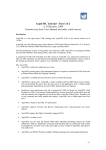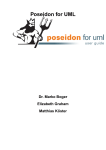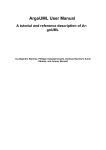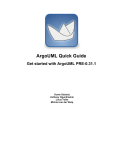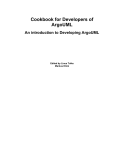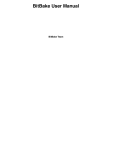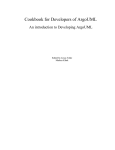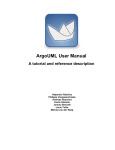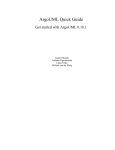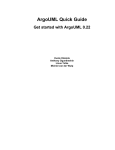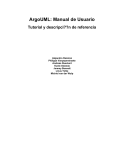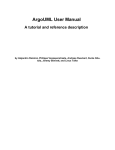Download ArgoUML Tutorial, Part 2 of 2 A. O`Riordan, 2009 Contains text from
Transcript
ArgoUML Tutorial, Part 2 of 2
A. O’Riordan, 2009
Contains text from User Manual and other cited sources
The Model
To enable modelling, CASE tools store models. A UML model describes a system using both
syntactic element definitions and diagram rendering. The model is the top level model
element within ArgoUML. In many respects in ArgoUML it behaves like a package.
ArgoUML is restricted to one model within the tool.
Explorer/Navigation Perspective
ArgoUML, like most CASE tools, provides a navigation tree for the designer to access the
various parts of the design. ArgoUML provides a rich set of tree-structured perspectives.
Within the hierarchical display, elements which have sub-hierarchies are indicated by when
the hierarchy is hidden and when the hierarchy is open.
The designer can choose a navigational perspective from the menu above the navigation tree.
There are pre-defined several navigational perspectives that support various tasks in objectoriented software design. Several views of the elements are available such as Package-centric,
Diagram-centric, and Class-centric.
Dropping a model element on a diagram is the equivalent of the "Add to Diagram" function.
Hence, if the diagram did not yet show this model element, it is added. One can use this drag
and drop feature to, for example, easily create a diagram from imported XMI files because
XMI files contain model elements, but not any diagram information.
For many systems, a single class diagram will be too complicated to show every association.
It is better to create a number of different class diagrams, each concentrating on one aspect of
the system. When a class that has been already defined is needed in a second or subsequent
diagram, drag its icon from the navigation pane into the new diagram.
The explorer allows the user to view the structure of a model from a number of predefined
perspectives. Note that not all model elements are necessarily shown in all perspectives.
Package-centric (the default). The exploring hierarchy is organized by package
hierarchy. The top level shows the model. Under this are all the top level packages in the
model and all the model elements that are directly in the namespace of the model.
Diagram-centric. In this view the top level comprises all the diagrams in the model.
Beneath each diagram is a flat listing of all the model elements on the diagram.
Class-centric. Shows classes in their package hierarchy as well as datatypes and use
case diagram elements.
The explorer is designed to be user configurable, to allow the designer to view in his or her
preferred way. The "Configure Perspectives" icon ( ) at the top left of the explorer brings
up the explorer perspectives dialog.
-1-
Button 2 Click over any selected model element in the main area of the explorer will cause a
pop-up menu to appear with options such as Copy Diagram to Clipboard as Image, Add to
Diagram, Delete From Model.
Model Property Toolbar
Go up: Navigate up through the composition structure of the model. Since the model is
the top package nothing can happen, and this button is always disabled.
New Package: This creates a new Package within the model (which appears on no
diagram), navigating immediately to the properties tab for that package.
New DataType: This creates a new DataType within the model (which appears on no
diagram), navigating immediately to the properties tab for that DataType.
Delete: This tool is always disabled, since it is meaningless to delete the model!
Property Fields For The Model
Name: The name of the model. The name of a model, like all packages, is by convention all
lower case.
Note: The default name supplied to a new model by ArgoUML, untitledModel, is thus
erroneous and guarantees that ArgoUML always starts up with at least one problem being
reported by the design critics.
Namespace: Records the namespace for the model. This is the package hierarchy.
However since the model is at the top of the hierarchy in ArgoUML, this box is always
empty.
Data Types
Standard data types, classes and packages are loaded as sub-packages of the model. These
sub-packages are not initially present in the model but are added to the model when used.
Within UML 1.4, DataType is a sub-class of the Classifier metaclass. It embraces the
predefined primitive types ( byte, char, double, float, int, long and short), the
predefined enumeration, boolean and user defined enumeration types. Within ArgoUML
new datatypes may be created using the New datatype button on the property tabs of the
model and packages.
ArgoUML allows user defined datatypes to be placed on class diagrams to define their
inheritence structure. It is represented on the diagram by a box with two compartments, of
which the top one is marked with «datatype», and contains the name. The lower one
contains operations.
Datatype Property Toolbar
Go up:Navigate up through the package structure.
New datatype: This creates a new datatype within the same package as the current
datatype.
New Operation: This creates a new operation within the datatype, navigating
immediately to the properties tab for that operation.
New Stereotype: This creates a new Stereotype within the same package as the
datatype, navigating immediately to the properties tab for that stereotype.
-2-
Delete:This deletes the datatype from the model.
Property Fields For Datatype
Name: The name of the datatype. The primitive datatypes all have lower case names, but
there is no formal convention.
Modifiers: Has entries Abstract, Leaf and Root. Abstract is used to declare that
this datatype cannot be instantiated, but must always be specialized. Leaf indicates that this
datatype can have no further sub-types, while Root indicates it is a top level datatype.
Visibility: Has entries public, private, protected, and package.
Generalizations: Lists any datatype that generalizes this datatype.
Specializations: Lists any specialized datatype.
Operations: Lists all the operations defined on this datatype.
Built-in Data Types
In ArgoUML Java datatypes, classes and interfaces are effectively organized as a hierarchy
beneath the overall model. They are grouped in four packages, lang, math, net and util,
themselves subpackages of java, which is a subpackage of the model itself.
You will not find build-in DataTypes, Classes, and Interfaces exposed within the model by
default (i.e. they are not present in the explorer). However, once you select one of the built-in
DataTypes, Classes, or Interfaces (in the "Type" combo-box on the property sheet of a
parameter of an operation of a class), then it becomes visible: you will find that the DataType,
Class, or Interface has appeared in the model, and in its correct package stucture for the latter
two.
Critics
ArgoUML has processes running in parallel with the design tool, evaluating the current
design against models of how “best practice” design might work. These processes are known
as design critics. ArgoUML is continually monitoring the changes you make to your models
and advising you of any problems that they may cause. This criticism of your model is
controlled by the Critique pulldown menu. By default the to-do items are organized into three
hierarchies by priority: High, Medium and Low.
Recommendations are given in the bottom right pane. This pane provides access to the advice
that comes from the Critics processes running within ArgoUML. A selector box at the top
allows a choice of how the data is presented (default is priority), a button allows the display of
the hierarchy to be changed, and there is an indicator of the number of to-do items identified.
-3-
As classes are added more to-do items will appear. The use of to-do lists to convey
suggestions from the design critics to the user
To-Do items can be added to any component you choose by clicking the To-Do tab in the
details pane. A new item is added by clicking on the topmost icon. Items can also be deleted
(dismissed), by highlighting the item in the To-Do pane, and then choosing the dustbin icon
from the left of the details pane. The relevant “offender” (for example class) will be
highlighted in red. They can also be put to sleep (“snooze”).
ArgoUML also provides electronic design checklists as a simple and flexible form of
knowledge support. Checklists, like critics, help designers identify design problems early
Menus
Many (but not all) actions that can be carried out on the menu can (and should) be carried out
in other ways as well under ArgoUML.
The following are the menus:
The File menu contains operations that affect on the whole project/file.
The Edit menu is generally intended for editing the model or changing the content of
a diagram. This menu is not intended for diagram layout functions.
The View menu is for functions that never alter the model, nor the diagram layout,
only the way you view the diagram. An example is "zoom". Also navigational
functions are here, e.g. "Find" and "Goto Diagram...". All changes of settings in this
menu apply to all diagrams (e.g. zoom).
The Create menu contains all possible diagrams that can be created. These functions
are context dependent, since they work on the selected model element.
The Arrange menu allows layout changes in the current diagram, which is not the
same as the items in the View menu. Functions here can not alter the UML model.
The Generation menu is for Code Generation. The functions here work either on the
selected model elements, or on the whole project.
The Critique menu is specific for settings related to critics, which apply for all
projects.
The Tools menu is currently empty. If plugins are installed, then their functions
appear here.
The Help menu contains the usual "information" and "about".
Settings
This menu item (Edit->Settings) brings up a dialog box, which allows the user to set various
options that control the behavior of ArgoUML. These settings are saved persistently for use
by subsequent ArgoUML sessions. The information to be saved in put the file
argo.user.properties. The location of this file is in the .argouml directory under
the "user’s home directory", which is defined as ${user.home}
The Profiles tab allows the user to configure the ArgoUML application settings related to the
profile. Available profiles are UML 1.4 (default), C++, Java and MetaProfile. Notation tab
allows the user to specify certain notation settings, i.e. how things are shown on diagrams.
This includes what to show by default, names, visibility, initial values, etc.
-4-
Export/Import
ArgoUML saves the diagram information in a PGML file (with extension .pgml, the model
information in an XMI file (with extension .xmi and information about the project in a file
with extension .argo. All of these are then zipped to a file with extension .zargo
Select a diagram, and then navigate to File=>Export Diagrams. You can generate GIF,
PostScript, Encapsulated PostScript or SVG format.
Beginning with ArgoUML 0.20, XMI 1.2 files are exported conforming to the UML 1.4
metamodel. Select the command File=>Export as XMI and choose a filename.
Note about proprietary vendor format - Some tools write non-standard XMI files either by
default or always. Here are some tips for getting standard files from a few known tools:
Poseidon - Turn off the option Save with diagram data in the Export Project to XMI dialog.
The Import XMI File option on the Tools or File menu (depending on your version) can be
used to import an XMI file from another tool.
Note that ArgoUML can not read an MDL file generated by Rational Rose. MDL is a
Rational Rose-specific format. You are much better off getting Rose to export an XMI file.
For now ArgoUML saves diagrams using an earlier proposed standard, Precision Graphics
Markup Language (PGML). However it has the option to export graphical data as SVG for
those who can make use of it
Tasks
(i) Export the diagrams from last week.
(ii) Export the models as XMI files. Download and run the free community edition of the
Poseidon for UML ™ tool (http://www.gentleware.com/) and import the XMI models.
Poseidon for UML is a commercial UML modelling tool derived from ArgoUML.
Note: Poseidon for UML (PfU) is delivered in different editions. The Community Edition is
the free base version. “It makes learning and using UML a snap and enables the cost-effective
exchange of models.” [Gentleware Website]. It fully supports UML 2.0. XMI 1.2 is supported
as a standard saving format. XMI 1.0, 1.1 and 1.2 can be loaded. Unlike ArgoUML, PfU
supports full Undo and Redo.
The Poseidon for UML work area is very similar to ArgoUML including a Navigation Pane, a
Drawing Pane, a Details Pane, and an Overview Pane (where the To-Do items were in
ArgoUML).
(iii) Draw a system architecture using package notation (Use Cass Diagram in ArgoUML)
-5-
Forward and reverse engineering
Without any plugin modules installed, ArgoUML supports only code generation of Java.
ArgoUML V0.20 and later supports the following languages by plugin: C#, C++, php4, and
php5.
The current version of ArgoUML will generate a structural template for your code, but is not
able to handle behavioral specifications to generate code for the dynamic behavior of the
model. Files are generated in a directory hierarchy that need to be filled in by the method
implementation code.
ArgoUML's Code Generation Window is displayed when you give a command to generate
code files. The table in the upper part of the window lists the classes that will be generated.
You can check or uncheck each class to refine the set of classes that will be generated. The
text field allows you to specify the output directory where the new class files will be stored.
The reverse engineering feature is in the menu: "File -> Import Sources...". Reverse
engineering in ArgoUML 0.26 can produce Class diagrams and Sequence diagrams (not fully
functional).
-6-






